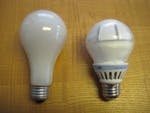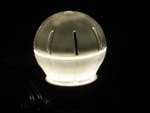The bulb emits 800 lm at 4000K, which is a colder white than most current LEDs. (3M's website lists it as also available in a warmer white, but no such bulb is listed on the Walmart site). The bulb consumes 13.5W, standard for a 60W LED replacement bulb.
Although 3M lists the bulb as dimmable, the company hedges by warning that the bulb is not compatible with all dimmers. My experience with dimming was that the bulb consistently flickered at a mid-way point. However, with power full-on, there was no flicker. There was virtually no noise – I had to put my ear right up next to the bulb, and even then heard anything only when the bulb was dimmed to its flicker “sweet spot.” Noise isn't a concern with this bulb. (Here's more information on the bulb's dimming as well as a video of its dimming performance).
Under the bulb cover is a giant metal heat radiator. It sits right next to the slits in the top of the bulb, which let the heat from the radiator out into the ambient air. It's now apparent that the plastic is not opaque white, but instead is a clear textured plastic. Figure 3 is a still from the 3M website video.
The Cree LEDs surround the base of the bulb, and their light is directed up and out through the plastic, which is actually a light guide. This explains why Figure 2 showed a greater amount of the light exiting at the bottom.
Since the bulb is dimmable, I wondered why 3M didn't use the 3445 rather than the 3444 and save on some external parts? Here is 3M Engineering's answer:
“...Our earliest efforts did involve the LM3445 to enable TRIAC dimmability. The circuit design was such that a sufficient current was consumed to exceed the holding current of most TRIACs. This means a few milliamps that results in a power waste and then it was still not guaranteed that any TRIAC dimmer would result in satisfactory performance. As a result, the circuit conversion efficiency was inferior.
[We] would like to point out that there are many commercial dimmers available that do not use TRIACs and that perform well with our present LM3444 circuit. If consumers desire dimmability, there is that option.”
3M opted to go their own route for dimming and one of the prime considerations was to save on holding current. My experience, as mentioned above, was that there was significant flicker with a TRIAC dimmer. On the other hand, the bulb was virtually noise-free.
The light pipe-based design played to 3M's strengths in the plastics field. This may be an indication of what 3M hoped to accomplish with this bulb, which, as a Walmart product, will see very wide distribution: By getting this design out in front of a large audience, 3M has immediately gained credibility for its light pipe design and light architecture, making it much easier to sell to more specialized and higher profit margin applications. From 3M's point of view this compensates for the relative heaviness of the product and any dimming limitations.
For more information on TRIAC dimming and additional pictures, visit this extended review of the 3M bulb.









